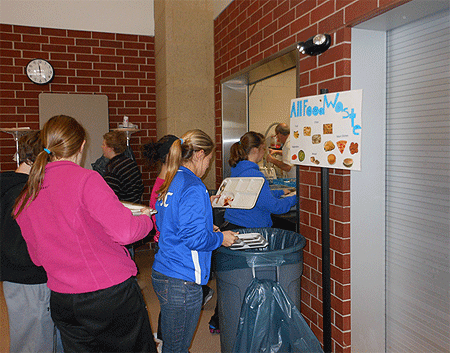Food Waste Diversion is Key to a Sustainable Community
By Lillianne Brown
Editor’s note: We’re happy to have this blog post from one of this year’s President’s Environmental Youth Award winners.
Over 20% of our country’s landfills consist of food we throw away.
When this organic waste breaks down in the landfill with other types of waste, it produces methane gas. When organic waste breaks down separate from the other waste in your composting bin, it creates carbon dioxide. Both methane and carbon dioxide are greenhouse gases, but methane is over 20 times more potent than carbon dioxide in trapping heat in the earth’s atmosphere. Plus, the compost created from the diverted organic waste is a nutrient rich soil that can be used to garden. Diverting food waste is important because it turns something usually considered waste into a resource, which also decreases the amount of emissions from landfills.
Our project, Zero Waste Composting, has worked with area businesses, restaurants and schools to help divert food waste from landfills. Reducing organic waste has had a significant impact here in Iowa City. Our landfill is able to now produce more compost for the community to use. More people are educated on why composting is important and how they can take part in reducing organic waste in landfills. And, it saves space in the landfills, is economically viable because it generates money for the landfill, and produces less harmful greenhouse gases.
The diversion process and its benefits shouldn’t only be limited to our community. Many communities can get involved and help decrease the amount of food waste being sent to their landfills. Diversion can take place in homes, schools, restaurants and businesses.
At home, families can create a backyard compost pile that can benefit their garden. Food scraps, like coffee filters, egg shells and vegetable and fruit scraps can all be composted in a home composting area. Schools, restaurants and businesses can also start diverting their food waste. It’s an easy transition, with many third-party businesses willing to help. Most food waste, including meat and dairy, can be diverted when being sent to a commercial composting facility. The food waste is then hauled away to a composting facility.
Other cities and towns can learn from our successes and divert food waste from their landfills as well. Communities should start by contacting their local landfill to see what options are available for organic waste diversion in their region. Schools, restaurants and businesses should then educate students, employees and consumers about the benefits of composting before implementing a diversion program. If a compost facility is unavailable in a region, communities can still divert organic waste by showing families how to create backyard compost piles and compost their home food and yard scraps. The model we used is simple, and many communities can implement it.
About the author: Lillianne Brown is a senior at Iowa City High School in Iowa City. She is a member of the Zero Waste Composting team and won the President’s Environmental Youth Award in 2014.


Dec 10, 2014 @ 18:35:27
Awesome!
Dec 11, 2014 @ 18:36:14
Thank you for that valuable information. 20% of food throw away ending up as a methane gas. This is unbelievable. Like the compost idea. As an environmental advocate, ND doctor and educator, I believe we could all work on changing our communities one at a time.
Dec 12, 2014 @ 18:36:48
I really loved this article and learned a lot of valuable information. How could the diversion of food waste impact out future? What changes could we see happening if we all converted to composting?